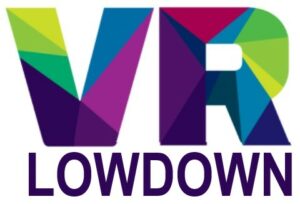As a huge flight simulator fan, I’ve spent a crazy amount of time playing DCS World and Microsoft Flight Simulator. They’re both incredible experiences, with enough content to consume your life, but they cater to slightly different audiences. If you’re just starting your journey into the world of flight simulation, this article is going to help you decide which is the best one to invest your time and money into.
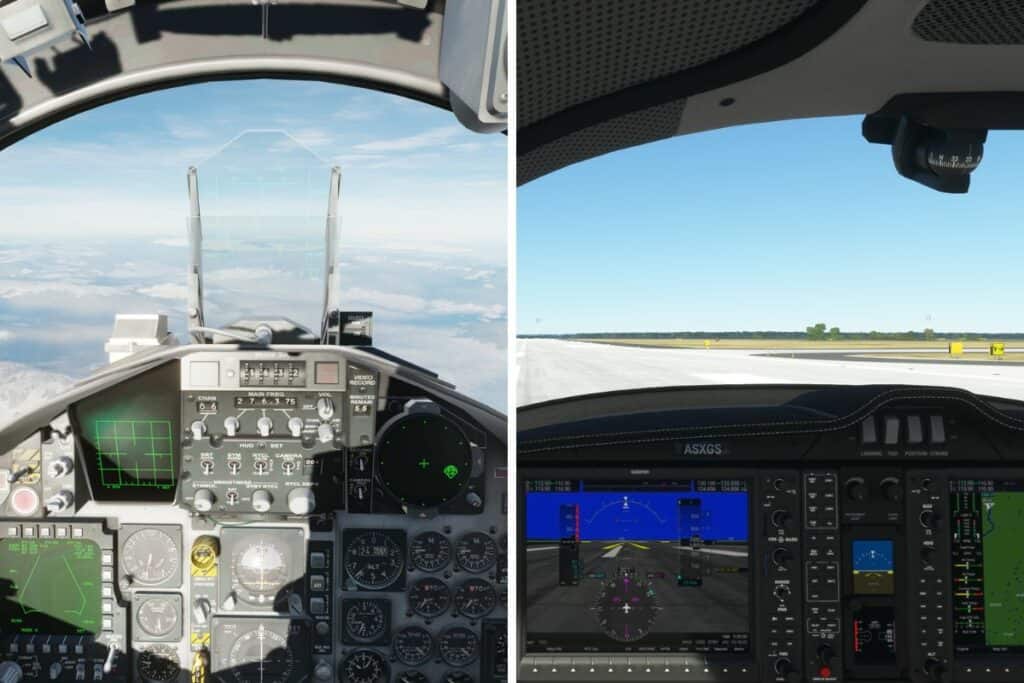
Introduction To DCS World
DCS World (Digital Combat Simulator World) was developed by Eagle Dynamics, a software company founded in 1991. DCS World was launched in 2012, but its roots can be traced back to the earlier titles by the same company, notably the “Flanker” series.
DCS World focuses primarily on military aviation and aims to provide a “study-level” flight simulator. In other words, it was designed to be as close to real-life military flight operations as possible.
As someone who has literally spent thousands of hours flying in DCS World, I can confidently say that it is an incredible flight simulator. The level of detail in the aircraft models and functionality and flight models is astounding. Almost every knob, switch, and gauge functions just as it would in an actual military aircraft.
Over the years, DCS World has expanded its aircraft roster and theatres of operation, continually refining its physics engine and graphics, and incorporating modern military hardware. This meticulous attention to realism is what sets it apart.
DCS World is available as a free download from the Eagle Dynamics website, and there is also a version available on Steam. I generally recommend choosing the standalone version in preference to the Steam version as it tends to get updates more promptly.
Introduction To Microsoft Flight Simulator 2020
Microsoft Flight Simulator, on the other hand, has a much longer history, with its origins going back to 1982. It is one of the longest-running, best-known, and most comprehensive home flight simulator programs on the market. Unlike DCS World, MSFS was designed with civilian aviation in mind. its focus was never on combat but rather on providing a realistic civilian flight experience.
With the launch of Microsoft Flight Simulator 2020, the series had a massive overhaul, updating this venerable series for a new generation of flight sim fans. MSFS provides a visually stunning and geographically accurate simulation of the entire planet.
It leverages the power of Bing maps to provide map data covering the whole globe, and supplements this with handcrafted points of interest, cities, and airports.
The aircraft are highly detailed, with fully interactive cockpits, and highly accurate aircraft systems and flight models. There is a vibrant marketplace of additional aircraft, liveries, and scenery, and they have even introduced some military aircraft and helicopters, to cater to an even wider audience.
Microsoft Flight Simulator is a much more accessible simulator, with assistance options to cater to complete beginners, whilst still offering an impressive simulation experience for enthusiasts. MSFS is available on Steam and also on the Microsoft store, either as part of Game Pass or as a separate purchase.
DCS World Vs Microsoft Flight Simulator
The bottom line is that Microsoft Flight Simulator is a more accessible game that is largely focused on civilian aviation. There is a good range of aircraft provided with the base game and you can fly anywhere in the world. It is suitable for complete beginners, right through to hardcore aviation enthusiasts, but doesn’t provide quite as accurate a simulation as DCS. You must purchase the base game, and additional content is available as paid DLC.
DCS is available as a free download that lets you fly in one large map covering the Caucasus region in one of two planes, the Sukhoi Su-25T ground attack aircraft, and the WWII TF-51D fighter. New maps and aircraft are available as premium DLC purchases, although you can try every aircraft for free for 14 days in every 6-month period.
DCS World is best for military flight simulator enthusiasts and for those who are happy to specialize in flying a smaller number of aircraft. DCS World is also undoubtedly the best helicopter simulator, with a growing range of exquisitely modeled helicopters. DCS World probably has greater attention to detail in terms of the accuracy of aircraft systems and flight models than MSFS.
It is a breathtakingly detailed military flight simulator that I have been playing for almost 10 years and one that I would wholeheartedly recommend. It’s not quite as accessible to newcomers as Microsoft Flight Simulator, and realistically, you will need a joystick as a minimum to play it, but there are few reasons not to check it out considering that the base game is free.
DCS World Vs Microsoft Flight Simulator: A Detailed Breakdown
Now that I’ve given you an overview of what to expect from each of these great flight simulators, let’s look at some of the individual aspects of each one, to help you decide which is the best option for you.
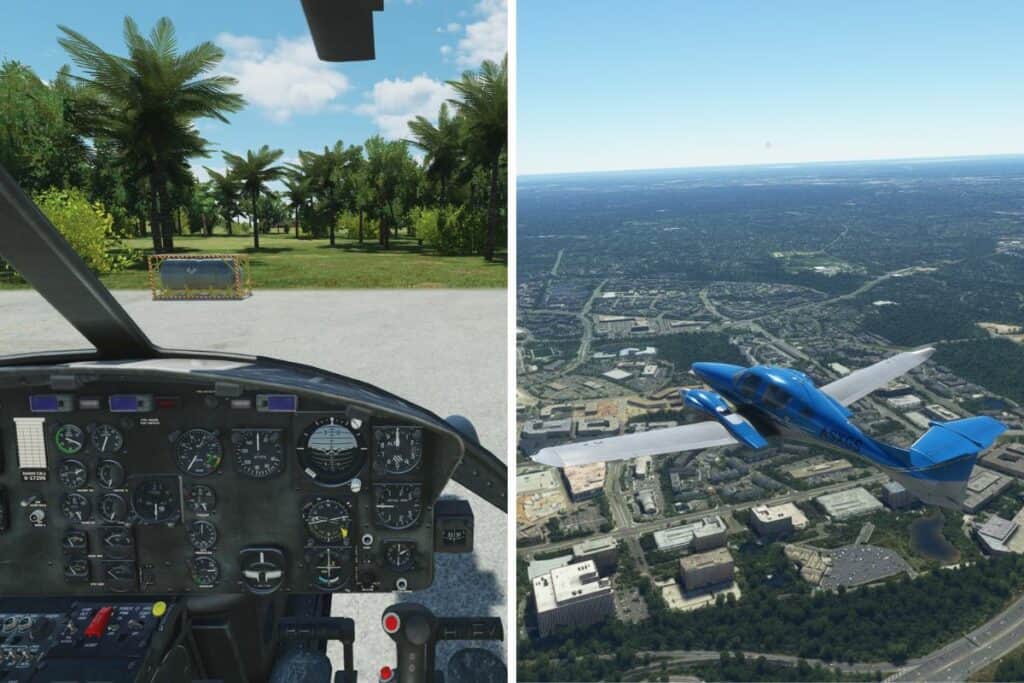
Graphics and Visuals
- DCS World has incredibly realistic and detailed aircraft models, and a steady stream of updates means that the graphics are incredible. It focuses on military aviation.
- Microsoft Flight Simulator has cutting-edge global photogrammetry scenery and looks incredible. The planes are detailed but don’t quite match the quality of DCS.
- Overall MSFS provides a more aesthetically pleasing experience for civilian VFR flying, while DCS better simulates the gritty realism of military aviation.
When it comes to graphics in flight simulators, both DCS World and Microsoft Flight Simulator are highly impressive. Microsoft Flight Simulator looks utterly stunning at higher graphics settings, but you will need a very high-end computer to achieve a high frame rate at high graphics settings.
The graphics in DCS World have been incrementally improved over the years, but have always been quite impressive. Thanks to continual improvements, DCS World’s graphics are now on par with MSFS in many ways.
DCS World has incrementally updated its graphics engine over time. The terrain and ground textures that once looked dated are now highly detailed and realistic. More importantly, DCS World’s aircraft models and cockpit textures remain second to none. The 3D cockpits are intricately modeled down to the smallest details. When experienced in VR, DCS World’s cockpits offer an unrivaled level of immersion.
Microsoft Flight Simulator uses photogrammetry and AI to render the entire planet with incredible fidelity. Flying low over recognizable cities is a visual treat thanks to the real-world data. MSFS can’t quite match DCS World’s cockpit detail, accuracy, and functionality, but provides jaw-dropping global scenery. Vivid terrain, water effects, and dynamic weather create stunningly beautiful vistas.
Regardless of which flight simulator you opt for, you will be able to enjoy stunningly beautiful graphics and highly accurate aircraft models. Both games require a high-end computer to run higher graphics settings, but both have a wide range of settings to adjust the graphics to meet the capabilities of your computer.
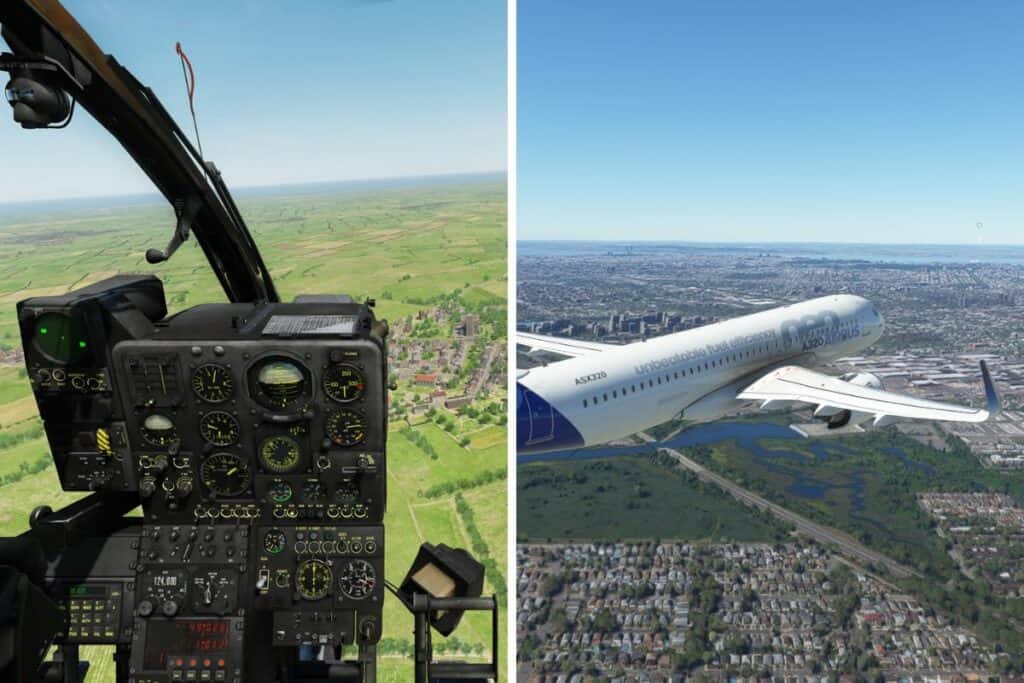
Realism And Flight Models In DCS And MSFS
- DCS World emphasizes extreme realism in its study-level aircraft simulations. Every switch and system is modeled. Very realistic flight dynamics.
- MSFS provides a solid flight model for GA aircraft but not quite as realistic as DCS. Simpler systems simulation. Still very impressive for a mass-market sim.
- If hardcore realism is key, DCS is superior. MSFS offers a great blend of accessibility and realism.
When it comes to accurately simulating the experience of flying different aircraft, the flight modeling and realism are make-or-break. Both DCS World and Microsoft Flight Simulator aim to replicate real-world flight dynamics, but DCS World takes it to the next level.
DCS World models its aircraft as intricately as possible, aiming for a “study sim” level of depth. The flight models are based on real pilot accounts and technical specifications. Every switch and system is carefully simulated. This makes the aircraft incredibly challenging but also extremely realistic to fly.
The flight modeling accounts for myriad factors like weight, fuel, drag, velocity, wind, and damage. Flying the aircraft in DCS World gives a true sense of what these machines are like in the real world.
Microsoft Flight Simulator also provides excellent flight models for its civilian planes. While not as meticulously modeled as DCS aircraft, MSFS flight dynamics are solid and realistic. The gameplay leans more towards accessibility than hardcore simulation, but the planes still react properly to controls and behave as expected. There is a depth versus accessibility trade-off compared to DCS World.
If you are looking for a more casual, accessible flight simulator, Microsoft Flight Simulator is the obvious choice. If you are looking for a more realistic civilian aviation experience, MSFS is again the best option. But if you want a meticulously realistic military flight simulation that lets you fly and engage in combat in one of the most realistic experiences outside of reality, DCS World goes the extra mile for true-to-life fidelity.
Aircraft Variety In DCS And Microsoft Flight Simulator
When it comes to available aircraft, DCS World and Microsoft Flight Simulator cater to different audiences with their respective focus on military and civilian planes.
DCS World features incredibly detailed study-level recreations of fighter jets from multiple eras. Some examples include the F-14 Tomcat, F-15C Eagle, F/A-18 Hornet, A-10 Warthog, and MiG-29 Fulcrum. Rotary wing enthusiasts can fly incredibly realistic combat helicopters like the UH-1 Huey, Mi-24 Hind, Ka-50 Black Shark and AH-64 Apache. Bombers, trainers, and other military aircraft round out an extensive hangar spanning history.
Each module is painstakingly created for maximum realism, often with input from real pilots. New aircraft are frequently released to expand the roster. Many of the new aircraft are developed by third-party studios, although some modules are created by the same development team that makes DCS World.
In contrast, Microsoft Flight Simulator has more of a focus on civilian light aircraft, commercial jets, and airliners. It includes classic single-engine prop planes like the Cub Crafters Cub and Beechcraft Bonanza. Larger piston twins are represented by aircraft such as the Beechcraft Baron G58 and Cessna 310.
Modern jets include the Cirrus Vision SF50 business jet, Boeing 747, and Airbus A320neo airliner. Rotorcraft options feature the Guimbal Cabri G2 helicopter and Bell 407. There are also a growing number of military aircraft, including the A10-C Thunderbolt II, F/A-18 Super Hornet, Eurofighter Typhoon, Harrier II, F-22 Raptor, and F-35 Lightning II.
Microsoft Flight Simulator has a vibrant DLC marketplace where you can purchase third-party aircraft and scenery and there is a mind-boggling amount of content available. There are currently over 300 flyable aircraft in MSFS and this will only grow as time passes.
You may be particularly keen to fly one plane or one type of aircraft, so you should definitely check out the list of aircraft available in DCS World and Microsoft Flight Simulator at the bottom of this article.
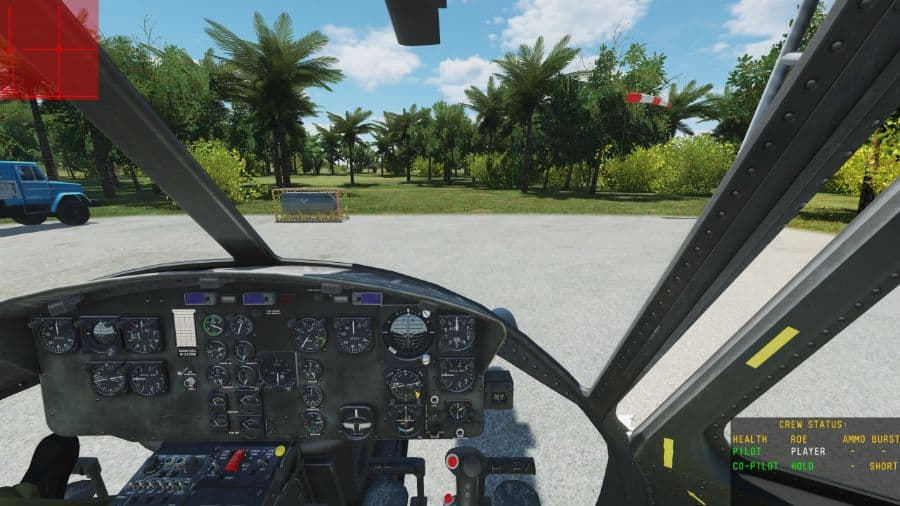
Environments And Scenery
- DCS is focused on military theaters – NTTR, Persian Gulf, etc. Very detailed but geographically limited.
- MSFS features the entire planet in impressive fidelity. Huge diversity of visuals and locations.
- MSFS scenery is a generation ahead. But DCS offers unparalleled realism for military sites.
When it comes to the rendered environments and scenery, DCS World and Microsoft Flight Simulator take very different approaches. MSFS provides the entire world in impressive fidelity, using topographical data and photogrammetry for the majority of terrain, with a smaller amount of hand-created cities and landmarks.
DCS on the other hand, has a smaller number of flyable maps that must be purchased separately. Whilst these are still enormous, they provide a more limited environment for flying in, but are almost exclusively hand-made.
The scenery in DCS World is concentrated on particular regions relevant to military aviation – maps like the Nevada Test and Training Range, Persian Gulf, Syria, and others. While not geographically diverse, these maps aim for maximum realism and detail of these real-world locations and military sites. Airbases, terrain, buildings, and ground units are meticulously created for combat immersion.
Microsoft Flight Simulator uses Bing Maps data and satellite imagery to construct the entire planet in impressive detail. From cityscapes to forests and deserts, the environments feel exceptionally realistic to fly over and explore. The automatic photogrammetry scenery exposes users to immensely diverse vistas.
Microsoft Flight Simulator has some hand-made landmarks, airports, and cities, but much of the rest of the architecture in the game is auto-generated. Whilst this looks impressive at first glance, if you fly over familiar cities or locations, you will soon notice that the buildings and layout usually bear little resemblance to their real-world counterparts.
Your choice between DCS and Microsoft Flight Simulator will depend on your preference to either have a perfectly constructed, but more limited area to fly in, or having the whole world, with some compromises.
Personally, I spend way more of my time flying helicopters in DCS and MSFS, so the ground architecture matters a lot more to me, and I generally prefer to use DCS World, but you will have your own ideas and preferences.
Ease Of Use And Accessibility
- DCS requires learning complex systems. High barrier to entry but very rewarding.
- MSFS is much easier to get into for casual users. More automated assists are available.
- DCS will appeal more to hardcore simmers wanting depth. MSFS is accessible to wider audience.
When it comes to getting started, DCS World and Microsoft Flight Simulator cater to different experience levels. DCS requires learning complex systems, while MSFS is more accessible for casual users.
DCS World does not compromise on realism, which means a steep learning curve. Mastering an aircraft requires studying the manual, knowing all systems and procedures. Casual enjoyment is still entirely possible, but it may consist of starting from airborne and enjoying some flying, rather than getting stuck into startup procedures and management of complex weapon systems. DCS rewards time investment with unmatched realism.
Microsoft Flight Simulator is designed for more casual accessibility while still providing realism. Auto-start functions and multiple assist modes allow new users to quickly get in the air. Menus and GUIs make navigation and flight planning simpler. The flight model still behaves realistically for a mainstream experience.
You can ramp up the degree of realism in Microsoft Flight Simulator as your confidence grows, and it is an impressively realistic and accurate simulation when you take the training wheels off.
For those seeking hardcore simulation, DCS World’s complexity provides immense satisfaction. Pilots looking for more casual fun will find MSFS easier to enjoy. DCS ensures immense depth for veterans. MSFS opens flight simulation to a wider audience. Ultimately it depends on whether you prioritize realism or accessibility.
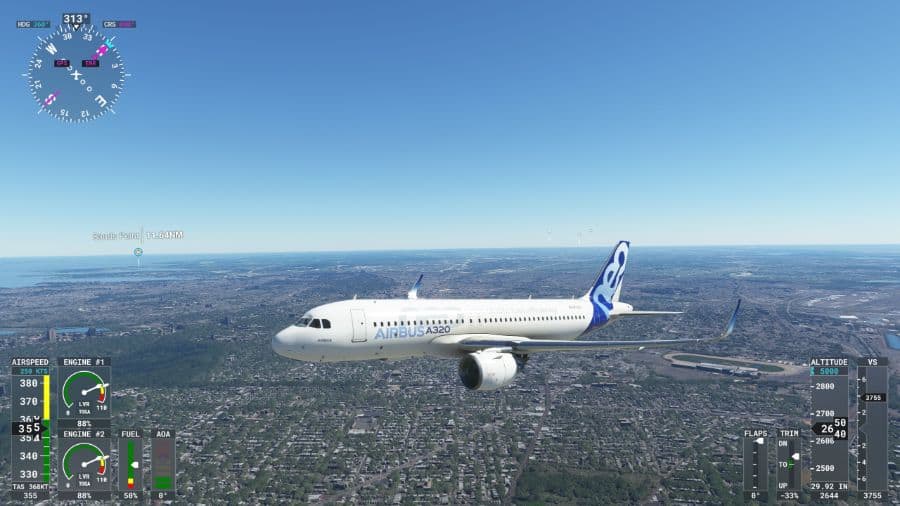
Business Model Comparison: DCS Vs Microsoft Flight Simulator
- DCS uses a modular payware model. Aircraft and maps are sold separately.
- MSFS has an affordable standard edition. It also has payware aircraft, scenery, and airports.
- Both have pros and cons. Payware modules enable highly detailed simulations.
DCS World and Microsoft Flight Simulator take different approaches when it comes to purchasing content and add-ons. DCS utilizes a modular payware model, while MSFS has a mix of paid and free content.
DCS employs a “free-to-play” base platform, with aircraft modules and maps sold separately. This lets users only pay for the specific content they want, but planes and environments must be purchased individually. Highly realistic aircraft like the F/A-18 and A-10C are premium-priced addons.
If you get sucked in by the allure of DCS World, it can become pretty expensive to purchase multiple terrain and aircraft modules, although they do have a number of sales per year, which can soften the blow.
Microsoft Flight Simulator has a standard one-time purchase base game. Aircraft are a mix of default and payware add-ons from both first and third parties. Scenery encompassing the entire planet is free, with some higher fidelity region DLC. Overall a wider variety of content is available without additional payments.
Both business models have pros and cons. DCS World’s payware approach funds intricate simulation of specific planes and areas. MSFS trades off depth for broader content access. DCS may provide better value for military aircraft fans. MSFS offers more flexibility for casual users.
Customization And Mods
- Huge modding and livery community around DCS. Fully customizable cockpits.
- MSFS has limited mod support currently but is improving. Livery selection is more limited.
- DCS allows almost unlimited customization. MSFS offers simpler personalization.
Both DCS World and Microsoft Flight Simulator have vibrant communities that create mods and liveries. DCS World has a great modding scene centered around creating new aircraft liveries. The ability to fully customize cockpit layouts also enhances immersion. User-made mods range from adjusting flight models to adding new weapons and systems. DCS supports extensive tweaking.
Microsoft Flight Simulator has more limited mod support at present. The livery options are still growing as third-party paints become available. MSFS allows some adjustability of weather, time of day, and camera tools, but does not enable the depth of customization as DCS. This may change as the platform matures.
For simulator fans who want to tailor every aspect of the experience, DCS World is hard to beat. Its open nature supports nearly endless user enhancements. MSFS offers more plug-and-play simplicity with less modding flexibility. DCS unlocks greater creative freedom.
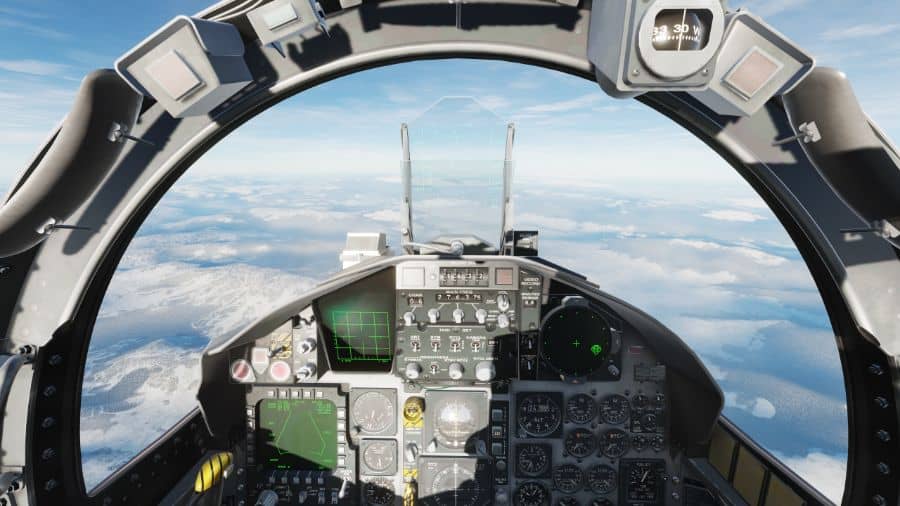
VR Support In DCS World And Microsoft Flight Simulator
For immersive virtual reality flying, both DCS World and Microsoft Flight Simulator support VR headsets. However, DCS World’s VR support is currently more robust and optimized.
The team behind DCS World has worked hard to integrate and optimize VR support over many years, and it generally works extremely well. Cockpit interaction works seamlessly in VR and DCS also offers better optimization and framerates in VR versus MSFS.
Microsoft Flight Simulator can be played in VR but isn’t quite as well optimized compared to DCS. Performance can be sluggish and there have been a number of technical issues since VR support was added in a post-launch update. Generally, I find VR in MSFS to work pretty flawlessly now, but it requires a top-of-the-range computer to run it at a decent frame rate without having to turn the graphics settings way down.
Unsurprisingly, I play both these games almost exclusively in VR and find both to provide a terrifically immersive experience. You’ll need a pretty beefy computer to run them both at reasonable frame rates, but the experience is unparalleled.
For the most polished and optimized VR flight simulation experience currently available, DCS World excels. MSFS offers immersive VR too but its implementation still needs refinement.
Multiplayer
When it comes to playing online with others, DCS World currently provides a more fully featured and robust multiplayer environment compared to Microsoft Flight Simulator.
DCS World was designed from the start with multiplayer capabilities in mind. There are many dedicated multiplayer servers available allowing combat missions and complex cooperative play. The ability to join squadrons enhances the sense of realism and coordination in DCS World multiplayer.
In contrast, Microsoft Flight Simulator supports playing online with others but the implementation is quite basic compared to DCS World. Shared flying in Microsoft Flight Simulator is limited to simple position and data syncing rather than the coordinated missions and battles available in DCS World. Microsoft Flight Simulator multiplayer does not yet capture the true sense of immersion and collaboration that DCS World provides.
This difference comes down to the military focus of DCS World lending itself naturally to multiplayer combat and operational missions. The civilian flight foundation of Microsoft Flight Simulator does not demand the same level of multiplayer functionality.
So for now, DCS World offers a far more polished and feature-rich online environment for squadron flying and combat operations. Microsoft Flight Simulator multiplayer shows potential but remains a work in progress when it comes to simulating real coordination between pilots.
List Of Aircraft In DCS World And Microsoft Flight Simulator
I’ve produced a list of all the aircraft that are currently available in DCS World and Microsoft Flight Simulator as of October 2023. This only includes officially available aircraft that either come with the base games or are available for purchase. There are also some unofficial aircraft that can be installed as mods, particularly for DCS World, such as the highly impressive AH-64D Apache module for DCS. Undoubtedly, these lists will grow over time.
Complete List of Aircraft in DCS World
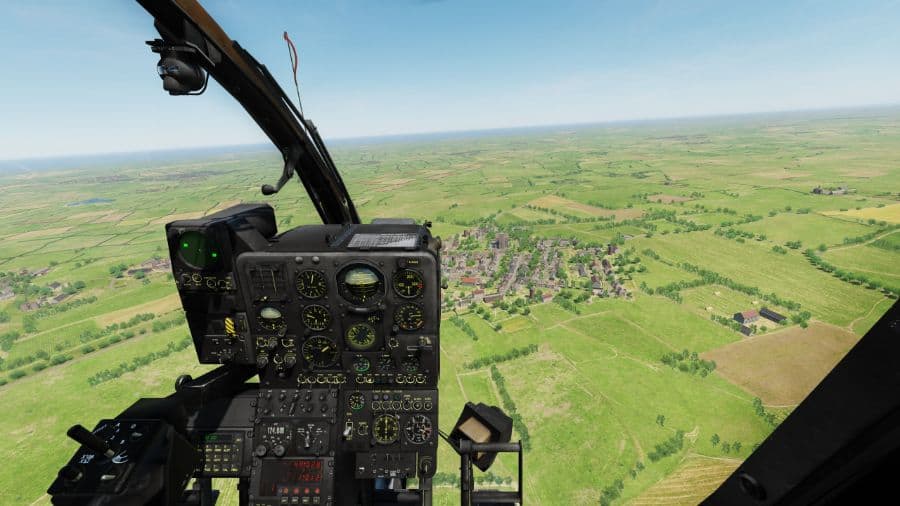
Modern Jets
- F-15E
- F/A-18C
- F-15C
- A-10A
- Su-27
- Su-33
- MiG-29A
- MiG-29S
- Su-25T
- Su-25
- F-16C Viper
- F-14 Tomcat
- MB-339
- Mirage F1
- A-10C II Tank Killer
- JF-17 Thunder
- MiG-19P Farmer
- AV-8B Night Attack V/STOL
- AJS-37 Viggen
- F-5E Tiger II
- M-2000C
- L-39 Albatros
- C-101 Aviojet
- MiG-15bis
- MiG-21bis
- F-86F Sabre
- Hawk T.1A
- A-10C Warthog
Helicopters
- AH-64D
- Black Shark 3
- Mi-24P Hind
- SA342 Gazelle
- Mi-8MTV2 Magnificent Eight
- UH-1H Huey
World War II Aircraft
- P-51D Mustang
- Mosquito FB VI
- P-47D Thunderbolt
- Fw 190 A-8
- I-16
- Christen Eagle II
- Yak-52
- Spitfire LF Mk. IX
- Bf 109 K-4 Kurfurst
- Fw 190 D-9 Dora
Complete List of Aircraft In Microsoft Flight Simulator
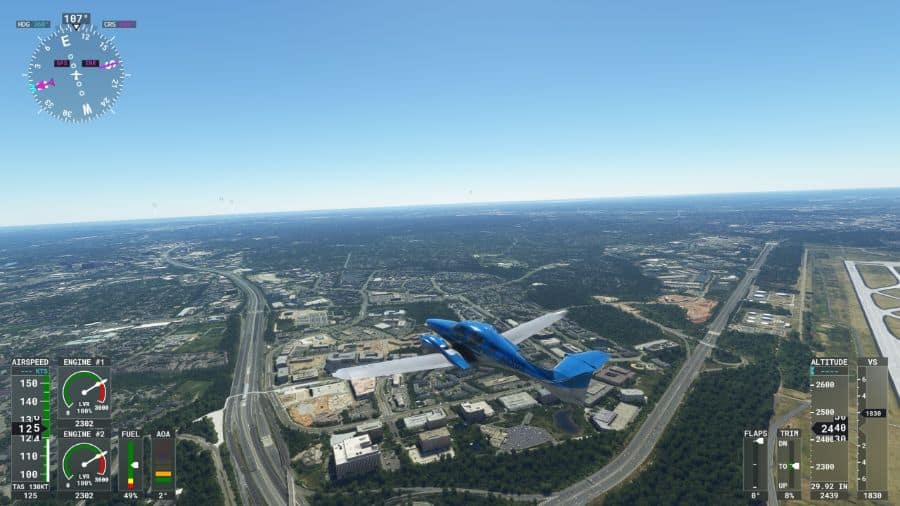
General Aviation (Single Engine)
- A1R Ryan ST-A Special
- Aerolite 103
- Aviat Pitts Special S1S
- Aviat Pitts Special S2S
- BD-5J
- Analog Bonanza
- Antonov An-2
- Bellanca Super Viking
- Bonanza G36
- Bonanza Turbo
- Bonanza H35 V-TAIL
- Bonanza V35
- BW 635RG
- BRISTELL B23
- Caproni-Vizzola C-22J
- Cessna 140
- Cessna 152
- Cessna 152 Aerobat
- Cessna 170B
- Cessna 172 Skyhawk (G1000)
- Cessna 172 Skyhawk
- Cessna 182RG
- Cessna 182T
- Cessna 208 B Grand Caravan
- Cessna 208 B Grand Caravan (Steam gauges)
- Cessna L-19 “Bird Dog”
- Cessna T-37B Tweet
- Cirrus SR22
- CubCrafters NX Cub
- Cub Crafter X Cub
- Daher TBM 930
- Diamond DA40NG
- Diamond DA40 TDI
- Diamond DV20
- Drifter 582 Ultralight
- Debonair 35
- EA-7 Edgley Optica
- Eagle S100
- EMB200 Ipanema Cropduster
- ERCO Ercoupe 415C
- EXTRA 330LT
- FK9 Mark 4
- Flight Design CTLS
- Focke-Wulf P.149D
- Gee Bee R3 Special
- Globe Swift
- Husky A-1C
- ICON A5
- Jabiru J160/J170
- J3C-65 CUB
- JMB VL-3
- Kitfox Series 5 & Trent Palmer’s Freedom Fox
- Kitfox Speedster Series 7
- KitFox STi
- Kodiak 100 Series II
- Kodiak 100 Amphibian
- Lake Skipper
- Lear Fan 2100
- Long EZ
- M20R Mooney
- Maule M7-235
- Monster NX Cub
- PA-11 Cub Special
- PA-28 Archer II
- PA-28R
- PA-28R Arrow III
- PA-28R Turbo Arrow III/IV
- PA-28-161 Warrior II
- PAC-750 XSTOL
- Piper L-4 Grasshopper
- PT-6A Porter
- Pilatus PC-6 Porter
- Pilatus PC-12
- Pipistrel Virus SW121
- Pitts Special S1S
- PZL-104 Wilga
- QUICKIE Q200
- Rans S6S
- Robin Cap10
- Robin DR400
- Sbach 342
- Scottish Aviation Bulldog
- SeaRey Elite
- Skywaves Amphibious Ultralight
- SIAI/Marchetti S.205-18/R
- Sting S4
- Socata TB-30 Epsilon
- SubSonex JSX-2
- Savage Gravel
- Savage Carbon
- Savage Obstruction
- Stream
- Sukhoi Su-31
- Super Menestrel HN-434
- Tanarg 912
- Tecnam P92
- Top Rudder Solo 103
- Trinidad TB21 GT
- Tutor T.1
- Van’s RV-7 & RV7A
- Van’s RV-8
- Van’s RV-10
- Van’s RV-14
- Velocity XL
- Vertigo Turbo Prop Racer
- Whittaker MW6
- Yak-18T
- Zenith STOL CH-701
- Zippy Sport
- Zlin Shock Ultra
- Zlin Savage Cub
General Aviation & Utility (Multi Engine)
- Analog Baron
- Beechcraft Baron G58
- Beechcraft King Air 350i
- Beechcraft King Air 350i Analog
- Beechcraft Model 99
- Camair 480 Twin Navion
- Canadair CL-215
- Canadair CL-415
- Canadair CL-515
- Cessna 310
- Cessna 337 Skymaster
- Cessna 414AW Chancellor
- Diamond DA62
- Double Ender
- DCH-4 Caribou
- Embraer EMB 121 Xingu
- MC Cri-Cri
- PA30 Twinkie
- PA-34T Seneca V
- PA-44 Seminole
- Partenavia P68B Victor
- Tecnam P2006T Mk II
- Twin Otter
Airliners
- 737-600
- 737-700
- 737-800
- 737-900
- 737 MAX
- 747-8
- 777s
- 767s
- 787
- A310
- A318
- A319
- A320
- Airbus A320neo
- A320neo
- A321neo
- A330-900neo
- A330-300
- Antonov An-225
- ATR 42-600/72-600
- BAe 146 Professional
- Boeing 314 Clipper
- Boeing 747-8
- Boeing 767-300ER
- Boeing 767-400ER
- Boeing 307 Stratoliner
- BN-2 Islander
- BN-2A Trislander
- Concorde
- CRJ 550/700/900/1000 Bundle
- DC-6
- Electra 10A
- Embraer E175
- Embraer 170/175
- Embraer 190/195
- EMB-110P
- Fly The Maddog X MD-82
- Fly the Maddog X MD-83/-88
- Fokker F28 Professional
- Junkers Ju-52
- L-1049 Super Constellation
- MD-11
Business Jets
- Cessna Citation CJ4
- Cessna Citation Longitude
- C510 Mustang
- Embraer Phenom 300E
- HJet HA-420
- Vision Jet G2
Military
- A10-C Thunderbolt II
- A-4E Skyhawk
- A6M5 ‘Zero’ and A6M-N ‘Rufe’
- Airbus A400M
- AT-6 Texan
- BF 109G-6
- B-52 Stratofortress
- Bell X-1A
- Boeing F/A-18 Super Hornet
- C-130E Hercules
- C-160 Transall
- C-17 Globemaster
- Dassault Mirage F1
- D77-TC Pelican
- de Haviland Vampire DH-100
- de Haviland Venom DH-112
- DHC-1 Chipmunk
- Embraer EMB-312 Tucano
- Eurofighter Typhoon
- F/A-18C
- F-117 Nighthawk
- F-14D Super Tomcat
- F-14 A/B Tomcat
- F-15C, D, E and I
- F-16C, D, and I
- F-22 Raptor
- F-35 Lightning II
- F6F Hellcat
- FG-1D Corsair
- Fouga CM.170 Magister
- Fiat G-91
- G39 Griffin
- Grumman F3F-2
- Hawk T1/A Advanced Trainer
- Hawker Hunter
- Harrier II
- L-39 Albatross
- MB-339
- M-346 Master
- MiG-15Bis
- MiG-21Bis
- MiG-29 Fulcrum
- MORANE D-3801
- MV-22B Osprey
- P-38L Lightning
- P-40B
- P-40F
- P-40N
- P-51 Mustang
- P-51D ‘Mustang’
- Pilatus PC-21
- Short Stirling
- Spitfire Mk1A
- Spitfire MK-IXc
- Sukhoi SU-57 Felon
- T-45C
- T-6 Texan
- TF-104 G Starfighter
- FRF-104G Starfighter
- Vought Crusader F8-E
- YAK-9 Frank
Gliders
- Discus-2c Glider
- Discus-2c Premium
- DG Aviation LS8-18
- DG-1001E neo
- DG-808S
- Rolladen-Schneider LS4
- SG 38 Schulgleiter
- Schleicher K7
Vintage
- Beechcraft Model 17 Staggerwing
- Beechcraft Model 18
- Bf108 Taifun
- Blériot XI
- Boeing 247D
- Bucker Bü-131 ‘Jungmann’
- Caudron Rafale 430
- Chilton DW-A1
- Curtiss JN-4 Jenny
- DHC-2 Beaver
- Dorand AR1 A2 200
- Dornier Do J Wal
- Douglas DC-3
- Fokker F.VII
- Ford Trimotor
- Fox Moth
- GeeBee Model Z and R-2
- Goliath F.60
- Grumman G44A Widgeon
- Grumman G-21 Goose
- Grumman Goose G21A Redux II
- Grumman Goose JRF-6B
- Hughes H-1 Racer
- Hughes H-4 Hercules
- Junkers F 13
- Latecoere 631
- Letov S-328
- Mignet HM.14
- Nieuport 17
- Nieuport 24
- Noorduyn Norseman
- Pasped Skylark
- PT-17 Stearman
- Savoia-Marchetti S.55 and S.55X
- Shavrov Sh-2
- Spartan 7W Executive
- Ryan NYP Spirit of St. Louis
- Tiger Moth
- Wright Flyer
- WYMF5
Helicopters
- AH-64D Apache
- Airbus H125
- Airbus H-135
- Airbus H-145
- Alouette III
- Astro ONE
- Bell 206
- Bell 206B3
- Bell 206L3
- Bell 222B
- Bell 407
- Boeing CH-47 Chinook
- Guimbal Cabri G2
- H125
- H-145
- Hurricane HC-450N
- Kamov Ka-10
- MD500E
- MD 530F
- Mini-500
- Robinson R44
- Schweizer 300
- Schweizer S300CBi
- Sikorsky S-76
- VoloCity
